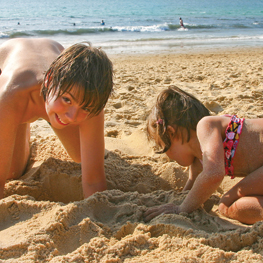
You stocked up on sunscreen, doled out sunglasses and floppy sunhats, and managed to coat your kids in gooey white SPF 30 before hitting the local swimming hole. But they still came home looking like lobsters, moaning and groaning over their painful sunburns. What gives?
Sunscreens are now part of most kids’ summer routines, but that doesn’t mean that all kids are as well-protected as they should be. According to the American Academy of Pediatrics, sunscreens are often less effective than parents think, because they aren’t applied correctly. And parents sometimes skip protecting dark-skinned children and tiny babies. Here’s how to get the best-possible sun protection for your brood, starting now.
Every kid, every day – Sun protection isn’t just for freckle-faced, blue-eyed kids, says Adelaide A. Hebert, M.D., a professor and director of pediatric dermatology. The sun doesn’t miss anyone. Sunburns may not be as visible on kids with darker complexions, but that doesn’t mean they don’t need SPF. Children with darker skin need to take the same sun safety precautions as their lighter-skinned pals.
Choose well – Staring down the sunscreen aisle at the drugstore can fluster even the most informed parent. Natural, baby, spray, sweat-proof – each passing year brings new innovations and more confusion. How can parents quickly and easily choose a sunscreen that’s right for their brood?
Forget about the multitude of subcategories and formulations, and focus on the two main types of sunscreens: chemical and physical. Chemical sunscreens, like Coppertone, actually absorb ultraviolet radiation. Many conventional sunscreens fall into this category. Physical sunblocks like those made by California Baby are made with ingredients that physically block the sun’s rays. They’re becoming increasingly popular with parents seeking a more natural option.
So which is best? The safest option, says Hebert, is to use both. Look for a combination product, like those made by Bull Frog or Helioplex. Or buy two, a conventional sunscreen and a physical sunblock, and layer them.
Labeling hype – Once you’re in the habit of reading labels, you may notice that formulations marketed for adults and children aren’t all that different. Manufacturers often market the same sunscreen product to both adults and children with different labels, says Hebert. So if your favorite kid’s sunscreen is out of stock, consider a grown-up brand instead.
To spray or not to spray – Spray sunscreens seem heaven-sent when you’re wrestling with a wiggly, impatient tyke. Not so fast – Hebert says parents using sprays often miss spots or don’t apply enough. “A spray sunscreen is still better than no sunscreen,” she says. “And the sprays are getting better all the time.” But for now, a tube or bottle may be your safest bet.
Apply for benefits – To get the full benefit of sunscreen, your application needs to be up to par. Many people don’t use enough, and sun protection is compromised further by water play, toweling off, even windy conditions. For best results, apply every two hours to clean, dry skin. The best time to apply the first coat is in the morning, when conditions are still cool, because sunblock won’t adhere as well to sweaty skin.
Protect tiny tots – There haven’t been enough studies proving sunscreen safety for babies below six months, so parents often skip protecting them. But infants are still susceptible to sunburns (and few things are worse than a sad, sunburned baby). Babies who spend lots of time outdoors can rack up significant sun exposure, even in the shade.
Hebert recommends that parents of young babies look for sunscreens containing zinc oxide or titanium dioxide, a common ingredient in diaper creams. If parents are safely using titanium dioxide to treat diaper rash, a sunscreen containing the same ingredients probably won’t cause an adverse reaction, she says.
Made in the shade – Wraparound sunglasses are more than a fashion statement. They offer 5 per cent more protection than regular shades and can reduce sun-induced cataracts if used regularly. Protect your kids’ peepers – and your sunglasses investment – by fastening shades to a strap so they stay on your child and don’t get lost.
Protective fashion – Photoprotective clothing is the next wave of sun protection. Brands like Coolibar, the first line to be certified by the Skin Cancer Foundation, offer clothing that blocks out 97 per cent of the sun’s UV rays. These garments are great options, says Hebert, but any tightly woven, dark clothing will protect kids from the sun.
To raise the protection factor for regular clothing, the Skin Cancer Foundation recommends Rit Sun Guard. This laundry additive washes into fabric, giving clothing an ultraviolet protection factor (UPF) of 30 for at least 20 launderings.
On the nose – The area many people miss when applying sunscreen? It’s as plain as the nose on their face. The nose is where dermatologists find most melanomas. “Think about where kids usually get pink – the nose,” says Hebert. So protect that cute sniffer now. Your child will thank you later.
Malia is a nationally-published health journalist and mom. Her latest book is Sleep Tight, Every Night: Helping Toddlers & Preschoolers Sleep Well Without Tears, Tricks, or Tirades.
Calgary’s Child Magazine © 2024 Calgary’s Child